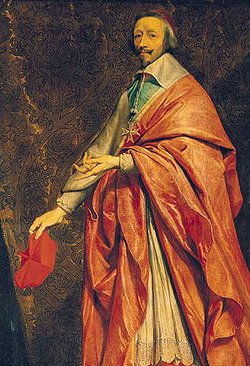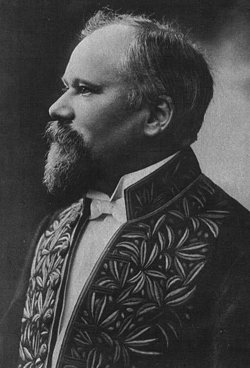|
|
The Académie française, or French Academy, is the pre-eminent French learned body on matters pertaining to the French language. The Académie was officially established in 1635 by Cardinal Richelieu, the chief minister to King Louis XIII. Suppressed in 1793 during the French Revolution, it was restored in 1803 by Napoleon Bonaparte. It is the oldest of the five académies of the Institut de France.
The Académie consists of forty members, known as immortels (immortals). New members are elected by the members of the Académie itself. Academicians hold office for life, but they may be removed for misconduct. The body has the task of acting as an official authority on the language; it is charged with publishing an official dictionary of the language. Its rulings, however, are only advisory, not binding on either the public or the government.
| Contents |
History
The Académie's origins lie in an informal group that met to discuss literature during the late 1620s and early 1630s. Cardinal Richelieu, the chief minister of France, later took the body under his protection. In anticipation of the formal creation of the body, several members were appointed in 1634. On 22 February 1635, at Richelieu's urging, King Louis XIII granted letters patent formally establishing the body; the letters patent were registered at the Parlement de Paris on 10 July 1637. The Académie française was responsible for the regulation of French grammar, orthography, and literature.
During the French Revolution, the National Convention suppressed all royal academies, including the Académie française. In 1792, the election of new members to replace those who died was prohibited; in 1793, the academies were themselves abolished. They were all replaced in 1795 by a single body called the Institut de France, or Institute of France. Napoleon Bonaparte, as First Consul, decided to restore the former academies, but only as "classes" or divisions of the Institut de France. The second class of the Institut was responsible for the French language, and corresponded to the former Académie française. When King Louis XVIII came to the throne in 1816, each class regained the title of "Académie"; accordingly, the second class of the Institut became the Académie française. Since 1816, the existence of the Académie française has been uninterrupted.
The President of France is the "protector" or patron of the Académie. Cardinal Richelieu originally fulfilled this role; upon his death in 1642, Pierre Séguier, the Chancellor of France, succeeded him. King Louis XIV took over the function when Séguier died in 1672; since then, the French head of state has always served as the Académie's protector. From 1672 to 1805, the official meetings of the Académie were held at the Louvre; since 1805, the Académie française has met at the Collège des Quatre Nations (now known as the Palais de l'Institut). The remaining academies of the Institut de France also meet at the Palais de l'Institut.
Membership
The Académie française has forty seats, each of which is assigned a separate number. Members are known as les immortels (the immortals) because of the device, À l'immortalité, that appears on the official seal of the body granted by Cardinal Richelieu. One of the immortels is chosen by his or her counterparts to be the Académie's Permanent Secretary; the Permanent Secretary serves for life, or until resignation. The Académie may, furthermore, appoint a former Permanent Secretary to the office of Honorary Permanent Secretary. The most senior member, by date of election, is the Dean of the Académie.
New members are elected by the Académie itself (the original members were appointed). When a seat falls vacant, one may apply to the Secretary if one wishes to become a candidate. Alternatively, the existing members may nominate other candidates. A candidate is elected only if he or she receives the votes of a majority of members voting; the quorum is twenty members. If no candidate receives an absolute majority, another election must be held at a later date. The election is valid only if the protector of the Académie, the President of France, grants his approval. The President's approbation, however, is only a formality. Then, the new member is installed at a sitting of the Académie. The new member must deliver a speech to the Académie, in which he or she customarily eulogises the member being replaced. Eight days thereafter, a public reception is held, during which the new member makes a speech thanking his counterparts for his election.
Members remain in the Académie for life. However, the body may expel an academician for grave misconduct. The first expulsion came in 1638, when Auger de Moléon de Granier was removed for theft. The most recent expulsions came at the end of the Second World War; Abel Bonnard, Abel Hermant, Philippe Pétain, and Charles Maurras were all excluded for their association with the Vichy regime. In total, twenty members have been expelled from the Académie.
There have been a total of 708 immortels, of whom four have been women (the first woman, Marguerite Yourcenar, was elected in 1980). Individuals who are not citizens of France may be, and have been, elected. Moreover, although most academicians are writers, one need not be a member of the literary profession to become a member. The Académie has included numerous politicians, lawyers, scientists, historians, philosophers, and senior Roman Catholic clergymen. Five French heads of state (Adolphe Thiers, Raymond Poincaré, Paul Deschanel, Philippe Pétain, and Valéry Giscard d'Estaing), and one foreign head of state (Léopold Sédar Senghor of Senegal) have been members. Other famous academicians include Louis, duc de Broglie, Alexandre Dumas, fils, Victor Hugo, Charles, baron de Montesquieu, Louis Pasteur, Henri Poincaré, and Voltaire.
Many notable French writers have not become members of the Académie française. In 1855, the writer Arsène Houssaye devised the expression "forty-first seat" for deserving individuals who were never elected to the Académie, because their candidacies were rejected, because they were never candidates, or because they died before appropriate vacancies arose. Notable figures in French literature who never became academicians include Honoré de Balzac, René Descartes, Denis Diderot, Gustave Flaubert, Molière, Marcel Proust, and Émile Zola.
The official uniform of an academician is known as l'habit vert, or the green habit. The habit vert, worn at the Académie's foreign ceremonies, was first adopted during Napoleon Bonaparte's reorganisation of the Institut de France. It consists of a long black coat and black feathered bicorne hat, each embroidered in dark green, together with black trousers or skirt. Furthermore, members receive a ceremonial sword (l'épée). Academicians who are women or clergymen do not receive swords.
Functions
The Académie is France's official authority on the usages, vocabulary, and grammar of the French language, although its recommendations carry no legal power. Sometimes, even governmental authorities disregard the Académie's rulings. The Académie publishes the official dictionary of the French language, known as the Dictionnaire de l'Académie française. A special Commission composed of several (but not all) of the members of the Académie undertakes the compilation of the work. The Académie has completed eight editions of the dictionary, which have been published in 1694, 1718, 1740, 1762, 1798, 1835, 1878, and 1935. It continues work on the ninth edition, of which the first volume (A to Enzyme) appeared in 1992, and the second volume (Éocène to Mappemonde) in 2000. In 1778, the Académie attempted to compile a "historical dictionary" of the French language; this idea, however, was later abandoned, the work never progressing past the letter A.
As French culture has come under increasing pressure with the widespread availability of English media, the Académie has tried to prevent the anglicisation of the French language. For example, the Académie has replaced loanwords from English (such as walkman and software) with French equivalents (baladeur and logiciel, respectively). Moreover, the Académie has worked to modernise French spellings and orthography. The body, however, has sometimes been criticised for behaving in an excessively conservative fashion. A recent controversy involved the creation of feminine equivalents for the names of several professions. For instance, in 1997, Lionel Jospin's government advocated using the feminine noun "la ministre" to refer to a female minister. The Académie, however, insisted on the traditional usage of the masculine noun, "le ministre," for a minister of either gender.
Prizes
The Académie française is responsible for awarding several different prizes in various fields (including literature, poetry, theatre, cinema, history, and translation). This function is relatively recent for the Académie; almost all of the prizes have been created in the twentieth century, and only two prizes were awarded before 1780. In total, the Académie awards over sixty prizes, most of them annually.
The most important prize is the grand prix de la francophonie, which was instituted in 1986, and is funded by the governments of France, Canada, Monaco, and Morocco. Other important prizes include the grand prix de littérature (for a literary work), the grand prix du roman (for a novel), the grand prix de poésie (for poetry), the grand prix de philosophie (for a philosophical work), and the grand prix Gobert (for a work on French history).
Current members
The current members of the Académie française are listed by seat number; the year of election is appended in parentheses.
- René Rémond (1998)
- Hector Bianciotti (1996)
- Jean-Denis Bredin (1989)
- Jean-Marie Cardinal Lustiger (1995)
- Assia Djebar (2005)
- Marc Fumaroli (1995)
- Jacqueline Worms de Romilly (1988)
- Michel Déon (1978)
- Alain Decaux (1979)
- Florence Delay (2000)
- Gabriel, prince de Broglie (2001)
- Jean, comte d'Ormesson (1973)
- Pierre Messmer (1999)
- Hélène Carrère d'Encausse (1990) (Permanent Secretary of the Académie)
- Frédéric Vitoux (2001)
- Valéry Giscard d'Estaing (2003)
- Érik Orsenna (1998)
- Michel Serres (1990)
- Pierre Moinot (1982)
- Angelo Rinaldi (2001)
- Félicien Marceau (1975)
- René, comte de Obaldia (1999)
- Pierre Rosenberg (1995)
- Jean-François Revel (1997)
- Jean Bernard (1975)
- Jean-Marie Rouart (1997)
- Pierre Nora (2001)
- Henri Troyat (1959) (Dean of the Académie)
- Claude Lévi-Strauss (1973)
- Maurice Druon (1966) (Honorary Permanent Secretary of the Académie)
- Jean Dutourd (1978)
- Alain Robbe-Grillet (2004)
- Michel Mohrt (1985)
- François Cheng (2002)
- Yves Pouliquen (2001)
- Jean-François Deniau (1992)
- René Girard (2005)
- François Jacob (1996)
- Bertrand Poirot-Delpech (1986)
- Pierre-Jean Rémy (1988)
See also
- List of all members, past and present, of the Académie française
- List of language academies
- Language policy in France
- Office québécois de la langue française
References
- L'Académie française. (Home Page). (http://www.academie-francaise.fr)
- Le Bars, Jean. (1907). "The French Academy." The Catholic Encyclopedia, Volume I. New York: Robert Appleton Company (http://www.newadvent.org/cathen/11456a.htm)
- Vincent, Leon H. (1901). The French Academy. Boston: Houghton Mifflin.de:Académie française
es:Academia francesa eo:Académie française fr:Académie française ga:Académie française nl:Académie française ja:アカデミー・フランセーズ pl:Académie française sv:Franska akademien


